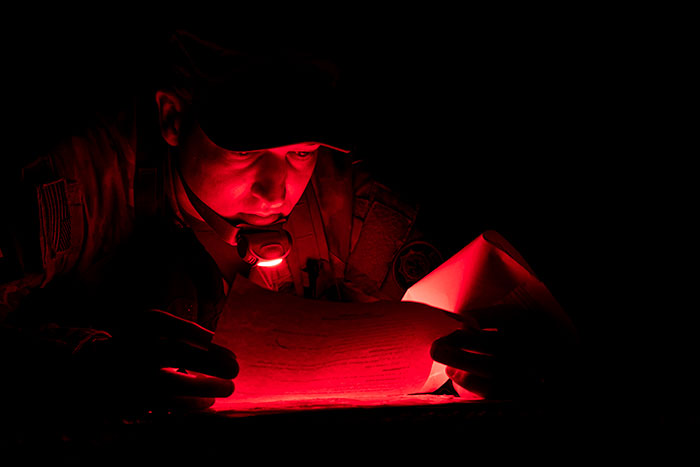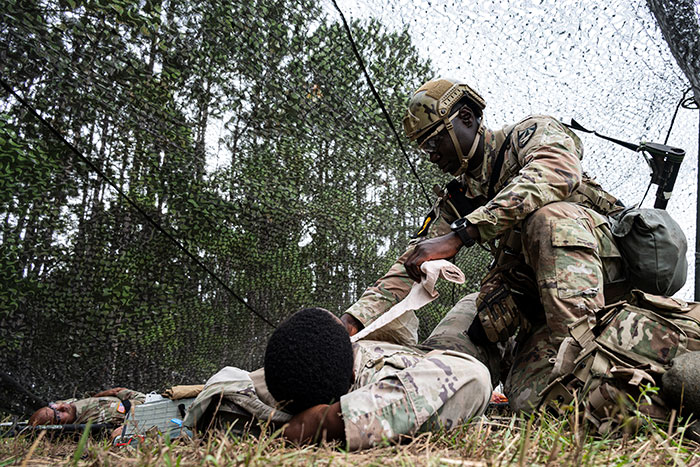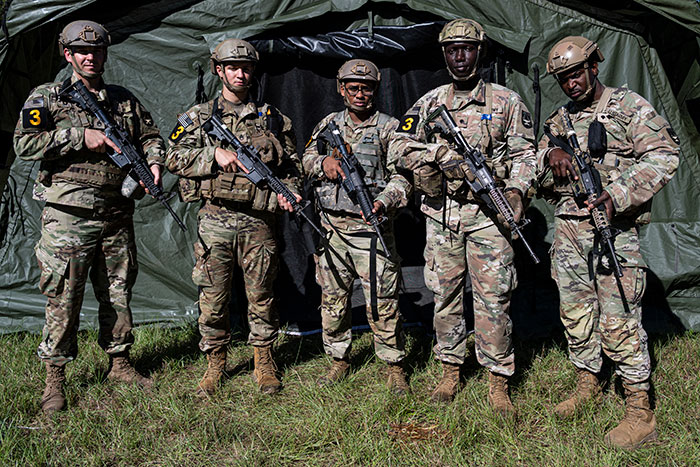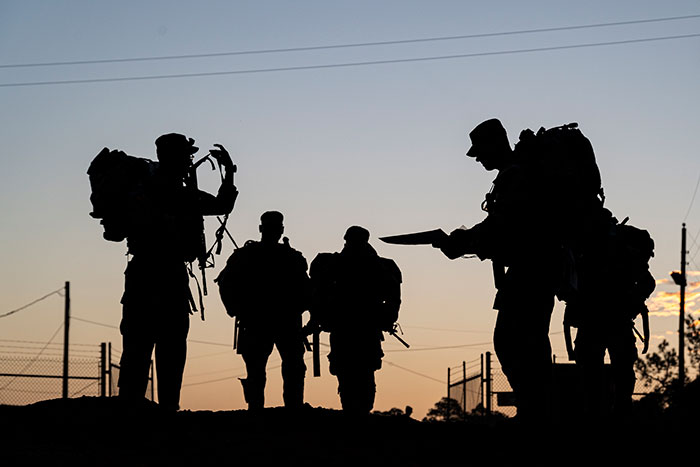Health monitoring system featured during Army-wide Best Squad Competition – USAMMDA team provides critical real-time health data for Best Squad planners

Team members with the U.S. Army Medical Materiel Development Activity are supporting the U.S. Army-wide Best Squad Competition this week and next, providing real-time health and performance data to the competition's supervisors at Fort Stewart, Georgia.
Each of the 60 competitors from across 12 U.S. Army commands composing 12 separate squads is wearing a Health Readiness and Performance System (HRAPS) device through the duration of the event. The HRAPS consists of a lightweight transmitter – about the size and shape of an earbud – that affixes to a wearer's chest with adhesive strips, and portable, handheld devices that receive and display physiological data for tactical leaders and medical providers at and near the front lines.
While the teams are vying for top billing as the best squad in the U.S. Army, the competition presents a perfect opportunity for the HRAPS development team to assess the program's progress in real-world conditions, according to Emily Krohn, assistant product manager for USAMMDA's HRAPS program.
"The HRAPS is a fantastic tool to help tactical commanders and frontline health care providers make critical decisions about Warfighters' health and performance during both training and real-world operations," said Krohn. "It is designed to help small-unit leaders and frontline medics identify possible health concerns before they become critical. It gives a snapshot of critical health and performance data about once a minute, so leaders can know their Soldiers' location and vital signs at all times whenever the device is transmitting data."
The Army-wide Best Squad Competition is the culmination of a series of command-level competitions that have taken place since the beginning of the year. It is designed to test competitors' tactical skills while demonstrating their commitment to the Army Values and Warrior Ethos. The competition is a challenging and exhausting event that mimics the rigors of combat operations, and it is a perfect showcase for the capabilities HRAPS offers to small-unit leaders during training, said Krohn.
"Because of the forecasted future nature of combat, it will be imperative to have modern, user-friendly, rugged, and expeditionary tools like HRAPS to help frontline commanders in the Joint Forces make more informed decisions," said Krohn, who travelled to Fort Stewart from USAMMDA's home at Fort Detrick, Maryland, to manage the HRAPS assessment. "The reality is that medevac capabilities found during previous operations, like in Iraq and Afghanistan, will be stretched very thin due to the possible operating environments of the future, where small teams will deploy far from higher echelon care facilities in austere, remote locations. It will be a critical advantage to have tools like HRAPS that will help provide advanced warning for health concerns that can point to deeper issues before they become emergencies. Having real-time health information for the Warfighters on the frontlines will help inform field medical care and maximize the effectiveness of available resources."

Wearable health monitors are not a new concept – health and fitness tracking devices have been in use in one form or another since the early 1980s. However, HRAPS, which has been in development at USAMMDA since 2018, is a step above anything that is commercially available, and it is designed specifically to enable faster small-unit leader decision making and provide enhanced troop accountability during intense training and future real-world military operations, according to Krohn.
"Not only does HRAPS provide real-time physiological data, it also gives commanders the locations of forces in the field during training," said Krohn. "We have been testing HRAPS during training and competitions like Best Squad 2023 during the past year, and anecdotally, there have been several instances where troops became lost. The HRAPS has helped commanders locate lost individuals several times, which is highly important for frontline leaders. Troop accountability is vital at all times, and HRAPS gives commanders a cutting-edge tool to maintain awareness of where their Soldiers are when they leave the wire."
Competitors in the event were selected from commands across the Army. The Army Futures Command team comprises Soldiers under the banner of the U.S. Army Medical Research and Development Command, experts in frontline medical care and medical technology development. According to Staff Sgt. Jesse Hylton, AFC team's senior leader and practical nursing specialist with the Telemedicine and Advanced Technology Research Center, the HRAPS is form-fitted for events like the Best Squad Competition where competitors are pushed to their limits, a close approximation of a combat environment.

"The HRAPS is a very useful tool for us out in the field, especially Soldiers in the medical services," said Hylton, who has served in the Army since 2015. "I had one monitoring my vitals during the AFC Best Squad competition and I was surprised at the capabilities it brings to the table. Having a tool like this as a medical provider, having this type of data real-time, would be extremely beneficial in a real-world environment."
While no training or exercise can truly replicate the intensity or mental and physical exhaustion of combat, the Best Squad Competition is nevertheless a comprehensive test of a Soldier's physical fitness and ability to endure under physical and mental duress. Long days under the Georgia sun, sleep deprivation, and calories burned combine to create clear physiological responses common during intense training and combat. Assessing the real-world applicability of HRAPS during events like the Best Squad Competition will give USAMMDA developers greater insights to improve and refine the development process, according to Hylton. It also points to the greatest value HRAPS gives leaders and medical providers on the frontlines: identifying medical issues before they become medical emergencies.
"During emergency situations while treating injuries and casualties, every minute counts, and having a baseline of physiological data tracked over a period of time would help inform decision making while treating Soldiers in the field," said Hylton. "We know that the effects of injuries compound over time, so being able to identify vital sign anomalies before they present in a patient is important to helping prevent possible complications with the onset of symptoms. If abnormalities do appear, we will be able to treat them early in the continuum, which would help mitigate injuries before they begin to escalate, and help providers apply a more holistic approach to casualty treatment, leading to better overall outcomes."














